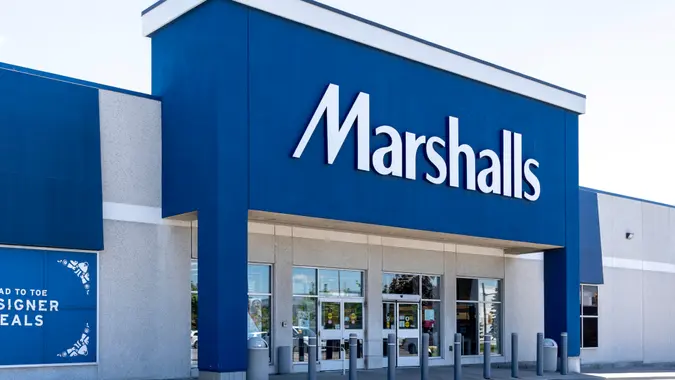5 Used Luxury Japanese Cars That Are a Bad Investment for Retirees
Commitment to Our Readers
GOBankingRates' editorial team is committed to bringing you unbiased reviews and information. We use data-driven methodologies to evaluate financial products and services - our reviews and ratings are not influenced by advertisers. You can read more about our editorial guidelines and our products and services review methodology.

20 Years
Helping You Live Richer

Reviewed
by Experts

Trusted by
Millions of Readers
Retirees often seek used luxury vehicles for comfort, convenience and perceived long-term value. But not all models deliver those benefits once the warranty expires and real-world costs begin to add up. A low sticker price on a luxury badge may hide expensive repairs, steep depreciation and insurance rates that stretch a fixed budget too far.
While some luxury Japanese brands deliver excellent value and reliability, others present higher risks due to depreciation and maintenance burdens. “Cars aren’t really investments, but it’s normal to hope they’ll still hold value when it’s time to sell,” said Lauren Fix, automotive analyst at Car Coach Reports. With that in mind, here are five models retirees may want to skip to protect their retirement savings.
In contrast, here are used luxury cars that are a good investment for retirees.
Infiniti QX80
The Infiniti QX80 is a large luxury SUV from Nissan’s premium brand, but its resale value drops sharply within just a few years. According to CarEdge, it depreciates by around 69% over five years, which is far worse than most full-size rivals. This steep decline can be financially disadvantageous for retirees seeking to preserve their investment.
This SUV’s hefty V8 engine, oversized tires and complex electronics lead to high running costs and repair bills after warranty, which would further strain fixed income retirees. That creates significant risk for retirees, especially those driving fewer miles or keeping the car long-term. Fix urges caution with older Nissan products because they “can get expensive to repair,” making the QX80 a questionable buy despite luxury appeal.
Mazda CX-9 Signature
Mazda doesn’t brand itself as a luxury automaker, but the CX-9 Signature edition pushes into premium SUV territory with upscale interiors and a high price. Despite its premium trim, the CX-9 loses 49.7% of its value over five years, which is steep for a flagship SUV, per iSeeCars report. That makes it a weaker choice for anyone counting on resale value to offset upfront costs.
Owners report turbocharged engine issues after extended use, especially in high-mileage pre-owned units. CarEdge reports average 10-year maintenance costs near $7,414 for Mazda models including the CX-9), a number that may surprise buyers who assume Mazdas are cheap to run. This makes the CX-9 Signature less appealing than alternatives like Toyota Highlander or Acura MDX, which hold value better and pose fewer mechanical risks.
Subaru Ascent Touring
The Subaru Ascent Touring is marketed as a premium, fully loaded SUV for families and older drivers who want comfort and safety tech. While it includes top-tier features, early model years raise red flags for long-term reliability. Consumer Reports found engine and transmission problems in 2019 and 2020 models, with poor ratings in both categories.
Depreciation is another downside. While not as steep as others on this list, the Ascent still holds less value than competitors after five years. Insurance rates also run high for a three-row SUV with a high-tech suite of safety systems. Fix notes that cars with costly repairs “should be avoided by retirees” and the Ascent’s mixed track record supports that advice. For fixed-income buyers, potential mechanical issues make the Touring trim a risky investment.
Nissan Maxima
The Nissan Maxima brings upscale finishes and strong V6 performance, but value retention is where it falls short. According to iSeeCar, a new Nissan Maxima depreciates 51.4 percent after five years, trailing behind similarly priced competitors. The Maxima’s biggest flaw lies in its transmission. Numerous owners have reported issues with its continuously variable transmission (CVT), which can fail outside of warranty.
RepairPal shows that one year of maintenance on RepairPal costs $540 on average, but CVT fixes can cost $3,000 or more. This is why Fix says that older Nissan models are not good picks for retirees because of these risks. The Maxima is not a good choice if you want a hard-working car that will sell quickly and need few repairs.
Mitsubishi Outlander PHEV
The Outlander Plug-In Hybrid (PHEV) may seem like a forward-thinking, fuel-efficient choice, but its long-term value tells a different story. Mitsubishi ranks at the bottom among Japanese brands for resale depreciating 50% after 5 years according to CarEdge. Additionally, the Outlander PHEV has been associated with reliability issues, which could lead to increased maintenance costs.
Older Outlander PHEV models also struggle with battery longevity, electronics failures and higher-than-expected repair costs. Fix directly warns against older Mitsubishi vehicles, citing their “expensive repair patterns” and weak resale history. For those in retirement hoping to cut fuel costs, a used Toyota hybrid would likely be a safer, more stable option.
More From GOBankingRates
 Written by
Written by  Edited by
Edited by 


























